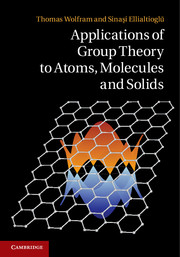Book contents
- Frontmatter
- Contents
- Preface
- 1 Introductory example: Squarene
- 2 Molecular vibrations of isotopically substituted AB2 molecules
- 3 Spherical symmetry and the full rotation group
- 4 Crystal-field theory
- 5 Electron spin and angular momentum
- 6 Molecular electronic structure: The LCAO model
- 7 Electronic states of diatomic molecules
- 8 Transition-metal complexes
- 9 Space groups and crystalline solids
- 10 Application of space-group theory: Energy bands for the perovskite structure
- 11 Applications of space-group theory: Lattice vibration
- 12 Time reversal and magnetic groups
- 13 Graphene
- 14 Carbon nanotubes
- Appendix A Vectors and matrices
- Appendix B Basics of point-group theory
- Appendix C Character tables for point groups
- Appendix D Tensors, vectors, and equivalent electrons
- Appendix E The octahedral group, O and Oh
- Appendix F The tetrahedral group, Td
- Appendix G Identifying point groups
- Index
- References
9 - Space groups and crystalline solids
Published online by Cambridge University Press: 18 December 2013
- Frontmatter
- Contents
- Preface
- 1 Introductory example: Squarene
- 2 Molecular vibrations of isotopically substituted AB2 molecules
- 3 Spherical symmetry and the full rotation group
- 4 Crystal-field theory
- 5 Electron spin and angular momentum
- 6 Molecular electronic structure: The LCAO model
- 7 Electronic states of diatomic molecules
- 8 Transition-metal complexes
- 9 Space groups and crystalline solids
- 10 Application of space-group theory: Energy bands for the perovskite structure
- 11 Applications of space-group theory: Lattice vibration
- 12 Time reversal and magnetic groups
- 13 Graphene
- 14 Carbon nanotubes
- Appendix A Vectors and matrices
- Appendix B Basics of point-group theory
- Appendix C Character tables for point groups
- Appendix D Tensors, vectors, and equivalent electrons
- Appendix E The octahedral group, O and Oh
- Appendix F The tetrahedral group, Td
- Appendix G Identifying point groups
- Index
- References
Summary
Definitions
A crystal or crystalline solid is an ordered array of atoms, molecules, or ions whose pattern or lattice is repeated periodically. A “single crystal” is perfectly ordered. Most crystalline solids are polycrystalline, meaning that they are composed of many small single crystals with defective, bounding surfaces between them. Large single crystals occur in nature, but often it is necessary to prepare them by special crystal-growth methods in laboratories. Single crystals are the preferred form for studying the intrinsic properties of a crystalline material.
Theoretical analysis of single-crystal properties usually assumes the crystalline structure is infinite or imposes periodic boundary conditions requiring the wave-function to repeat itself after a sufficiently large number of chemical units. This is a reasonable approximation, since a cubic-centimeter crystal contains on the order of 1022 to 1024 repeated units.
To sharpen our description of a lattice some definitions are useful.
• Bravais lattice. A Bravais lattice is a space-filling array of points generated by three primitive lattice vectors, a, b, and c. The vectors of the infinite set of vectors {R(l, m, n)} terminate on the Bravais lattice points. These vectors are R(l, m, n) = la + mb + nc, where l, m, and n are positive or negative integers or zero. Instead of the vectors a, b, and c, a Bravais lattice can be specified by the magnitudes of the primitive vectors, a = |a|, b = |b|,and c =|c|, and the angles between them, α, β, and γ.
- Type
- Chapter
- Information
- Applications of Group Theory to Atoms, Molecules, and Solids , pp. 239 - 279Publisher: Cambridge University PressPrint publication year: 2014



